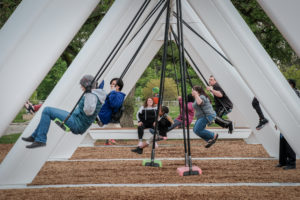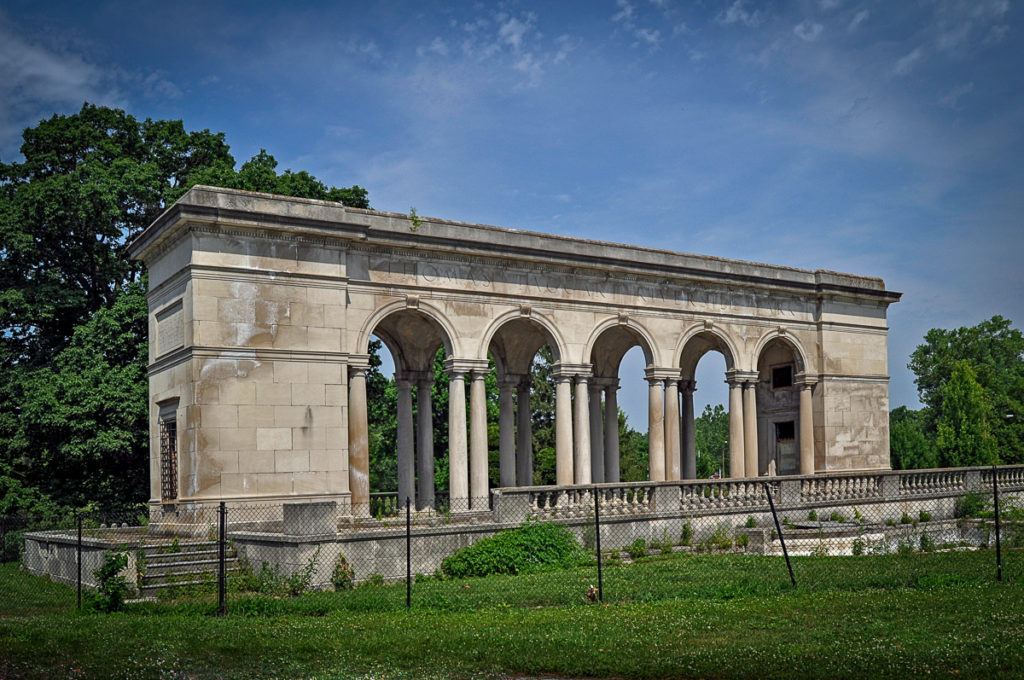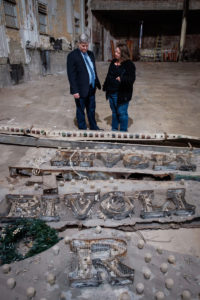When Lilly Endowment announced its $25 million Strengthening Indianapolis Through Arts and Cultural Innovation initiative in January 2018, it invited people who care about the quality of life in Indianapolis to imagine and to dream.
How can the arts and other cultural offerings make the city more livable for all of its residents? What can arts and culture do to make Indianapolis more inviting to tourists? How can the arts help newcomers put down roots and make Indianapolis their home?

Cultural Campus at Fort Harrison
By summer, more than 200 organizations from diverse sectors had submitted their ideas: ideas that revealed intriguing new collaborations among varied organizations; ideas that reflected passionate commitments to corners of the city that are underappreciated; ideas that uncovered projects often put on the back burner because funding was out of reach.
There were so many strong ideas that in late autumn the Endowment nearly doubled its funding for the initiative, awarding just under $49 million in grants to support 17 projects. The grants were in addition to the Endowment’s regular grantmaking to support arts and culture organizations, most of them based in Indianapolis. The projects funded are varied in approach and scope, from one-time events to efforts to transform Indianapolis landmark institutions.
“It is quite forward thinking to call for charitable organizations of all kinds, not just arts and culture organizations, to take on an arts and culture project,” said Robert L. Lynch, president and CEO of Washington, D.C.-based Americans for the Arts, an organization that advances the arts across the United States. “This is the future of arts support. It’s a great initiative, it’s important, and it’s the kind of work that should be encouraged in communities where you have projects in the arts linked with advancement of different issues within the community.”
Closer to home, the grants have caught the attention of leaders in the Indianapolis corporate sector who are keenly aware of how important a healthy, innovative cultural landscape is for a city. Quality of place is important when it comes to attracting and retaining the new and diverse talent Indianapolis needs to strengthen companies, according to David L. Johnson, president and CEO of the Central Indiana Corporate Partnership (CICP). CICP is an Indianapolis-based organization that brings together executive leadership from industry, academia and philanthropy to advance regional prosperity.
“These transformative grants from the Endowment will enable Indianapolis to truly shine—for those who live and work here today and for the many more we hope will be coming to join us in growing our economy,” says Johnson.
“These transformative grants…will enable Indianapolis to truly shine.”
Partners find common ground
Indy Parks needed resources. Indiana Landmarks wanted to restore a monument. And Indy Shakes—the Indianapolis Shakespeare Company—sought a permanent home for performances. The Indianapolis Parks Foundation brought them together, and they all got what they were looking for in the form of a $9,240,000 Endowment grant to revitalize the Taggart Memorial Mainstage Amphitheatre in Riverside Park on the west side of Indianapolis.
Construction and restoration are expected to be complete by the end of 2019. Erected in 1931, the Taggart Memorial is named for Thomas Taggart, the Indiana political leader who helped create Riverside Park. He served as Indianapolis mayor from 1895 to 1901, then as head of the Democratic National Committee and briefly as a U.S. Senator. The restored memorial will become the backdrop for an outdoor amphitheater that will feature free Indy Shakes performances each summer as well as Indy Parks’ free summer concert and movie series.

Taggart Memorial
“Lilly Endowment is giving us the chance to shine the jewels that we have and set it up so we can keep them shiny,” says Lori Hazlett, president of the Indianapolis Parks Foundation. “Each organization is going to be able to fulfill its mission. And we get to do it together, which makes it even better.”
On the other side of town, the John H. Boner Community Center and eight other Eastside organizations will work together on the 10 East Art & Design District, using arts-based economic development strategies to develop a one-mile corridor of East 10th Street.
Boner CEO James Taylor says the $4,319,218 grant will support multiple endeavors, including reclaiming vacant properties on 10th Street for creative reuse, transforming underused public places into vibrant spaces, and increasing neighborhood arts programming. Plans includes creating a system that helps artists book temporary spaces to display their work, developing housing that artists can purchase or rent so they can live in the neighborhood creating arts programming for the neighborhood.

10 East Art & Design District
“Arts can be a force for changing people’s lives, for changing people’s perspective, for changing a commercial corridor within a neighborhood,” Taylor says. “That has the effect of changing the community itself.”
While the Taggart and 10 East Arts & Design District grants will transform two specific locations, the Creative Placemaking Neighborhood Training Program will help 30 Indianapolis neighborhood associations and leaders create an array of creative placemaking projects.
Supported by a $553,561 grant, the Indianapolis Neighborhood Resource Center (INRC) and the Harrison Center are jointly conducting the program, which helps groups across the city use the arts to engage residents in improving their neighborhoods.
INRC Executive Director Anne-Marie Taylor says her organization contacted Harrison Center to pitch the idea of working together. She believes INRC has the neighborhood contacts and programming in place through its Indianapolis Community Building Institute and Harrison Center has the know-how to generate arts projects and experience working successfully with neighborhood groups.
“The opportunity for us to work with people in 30 neighborhoods, as they think about what makes each neighborhood a destination, is really exciting,” Anne-Marie Taylor says. “This has the potential to transform the city.”
Expanding the audience
While INRC is working to improve the inclusion of the arts in neighborhoods, the Indiana Blind Children’s Foundation’s No Limits Arts Series project will work to strengthen inclusiveness in the arts for individuals with disabilities. At the center of the three-year, $1,003,167 grant is a plan to help high school students at the Indiana School for the Blind and Visually Impaired (ISBVI), which is supported by the foundation, become advocates for improving access to the arts.
Taking part in a new school leadership club, students will work alongside ArtMix and advise leaders from the Eiteljorg Museum of American Indians and Western Art, Heartland Film, Phoenix Theatre, Dance Kaleidoscope, and Capital City Chorus about how they can become more accessible to persons with disabilities, including those with visual impairments.
At the same time, Indiana Blind Children’s Foundation Executive Director Laura Alvarado says, “Many people don’t understand what happens here at the School for the Blind. We need to become more open and accessible to people who are not familiar with our community.”
The grant will help fund renovations at the school to foster increased arts programing for the public, including a community performance each July that will mark the anniversary of the landmark federal legislation, the Americans With Disabilities Act. The ISBVI will be updating audio, lighting, film and other technical specifications in its auditorium to improve everyone’s experience there.
A destination for all seasons
Expanding the audiences that visit the grounds of one of Indianapolis’ most prominent cultural institutions is central to the $8 million grant to Newfields, home to the Indianapolis Museum of Art and the Virginia B. Fairbanks Art & Nature Park. Building on research about what attracts people to visit museums and gardens and experimentation with various concepts throughout its campus, Newfields will use its grant to fund infrastructure improvements, including creating a place for a culinary arts department. The grant also will support new seasonal programs. The first will be Harvest in 2019, which will explore the bounty of autumn through outdoor art installations, large-scale performances and horticulture displays.

Newfields
Newfields has expanded visitor engagement in recent years with Winterlights, an annual multi-faceted holiday lights display, and Spring Blooms, a seasonal celebration of the botanical gardens throughout the Newfields campus.
“We are extremely excited by the Endowment’s investment in Newfields’ future. The grant will enable us to advance our strategic plan to create exceptional seasonal programming at the intersection of art and nature, which is our mission,” says Charles Venable, the Melvin & Bren Simon Director and CEO at Newfields.
Reflecting on the grant to Newfields and the entire field of grants in the initiative, Venable adds, “Years from now people will look back and realize this was a watershed moment in the development of Indianapolis’ quality of life.”
Grants were awarded to 18 organizations funding 17 projects. Ranging from $49,000 to $9,240,000, the grants fund a variety of arts and culture projects, including one-time events, strategic capital improvements and long-term community partnerships.